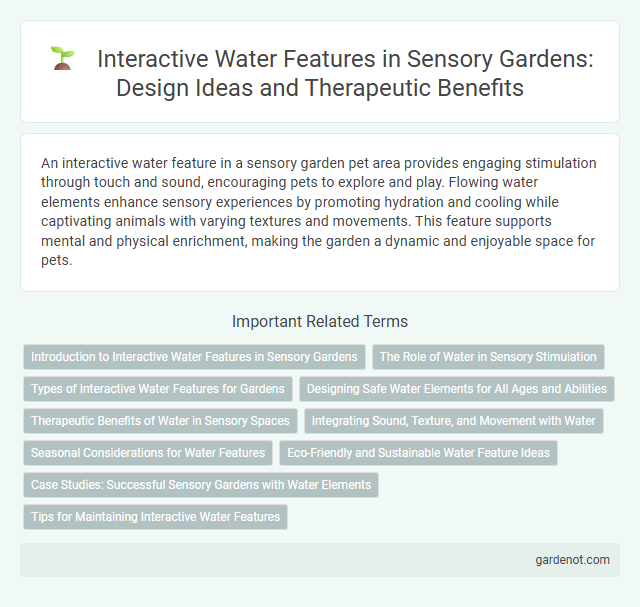An interactive water feature in a sensory garden pet area provides engaging stimulation through touch and sound, encouraging pets to explore and play. Flowing water elements enhance sensory experiences by promoting hydration and cooling while captivating animals with varying textures and movements. This feature supports mental and physical enrichment, making the garden a dynamic and enjoyable space for pets.
Introduction to Interactive Water Features in Sensory Gardens
Interactive water features in sensory gardens engage multiple senses through the dynamic interplay of sound, touch, and sight, offering therapeutic and educational benefits. Elements such as bubbling fountains, mist sprays, and textured water tables promote tactile exploration and stimulate cognitive development for individuals of all ages. These features enhance sensory stimulation, encouraging relaxation and social interaction in an inclusive outdoor environment.
The Role of Water in Sensory Stimulation
Water in sensory gardens provides dynamic tactile and auditory stimuli that engage multiple senses simultaneously. Interactive water features, such as fountains or streams, encourage exploration through touch and sound, enhancing sensory integration and cognitive development. The flowing movement and varying temperatures of water activate sensory receptors, promoting relaxation and sensory awareness.
Types of Interactive Water Features for Gardens
Interactive water features for sensory gardens include fountains, splash pads, and water walls, each designed to engage multiple senses through touch, sight, and sound. Fountains offer rhythmic water flow and calming sounds, while splash pads provide playful water jets that change patterns and intensity, encouraging tactile exploration. Water walls combine visual movement and gentle water contact, enhancing sensory stimulation with varying textures and temperatures.
Designing Safe Water Elements for All Ages and Abilities
Designing safe water elements in a sensory garden requires non-slip surfaces, shallow depths, and accessible controls suitable for all ages and abilities. Incorporating smooth edges, gentle water flow, and barrier-free access enhances safety while engaging multiple senses. Water features with adjustable flow settings and tactile components provide an inclusive, interactive experience promoting sensory exploration and motor skills development.
Therapeutic Benefits of Water in Sensory Spaces
Interactive water features in sensory gardens enhance relaxation and reduce stress by engaging multiple senses through tactile and auditory stimulation. The therapeutic benefits of water include improved mood, lowered heart rate, and increased mindfulness, promoting emotional well-being. These features create a calming environment that supports sensory processing and encourages gentle physical activity.
Integrating Sound, Texture, and Movement with Water
Interactive water features in sensory gardens combine sound, texture, and movement to engage multiple senses simultaneously, creating a dynamic and immersive experience. Textured surfaces such as smooth stones, ridged tiles, and bubbling jets produce varied tactile sensations while the flowing water generates soothing auditory stimuli. Movement elements like rotating wheels and cascading streams invite touch and exploration, enhancing sensory interaction and promoting relaxation and curiosity.
Seasonal Considerations for Water Features
Interactive water features in sensory gardens require careful seasonal planning to maintain safety and functionality; during winter, water elements must be drained or equipped with heaters to prevent freezing and damage. Seasonal plant growth and wildlife activity around water features influence water quality, necessitating regular cleaning and filtration adjustments in spring and summer. Adapting the design to local climate ensures year-round engagement, enhancing sensory stimulation through changing water temperatures, sounds, and movement patterns.
Eco-Friendly and Sustainable Water Feature Ideas
Interactive water features in sensory gardens utilize recycled water systems and solar-powered pumps to minimize environmental impact while enhancing user engagement. Incorporating native plants around water elements supports local biodiversity and natural filtration, reducing the need for chemical treatments. Sustainable designs emphasize rainwater harvesting and permeable surfaces to conserve resources and maintain ecological balance.
Case Studies: Successful Sensory Gardens with Water Elements
Case studies of successful sensory gardens with interactive water features highlight their role in enhancing user engagement and multisensory stimulation. Examples such as the Chicago Botanic Garden's Cranberry Lake feature demonstrate how adjustable water jets and tactile pools promote therapeutic benefits and accessibility for individuals with diverse sensory needs. Incorporating elements like gentle water sprays and textured surfaces fosters relaxation and cognitive development, making these gardens effective tools in horticultural therapy and community wellness.
Tips for Maintaining Interactive Water Features
Regular cleaning of pumps and filters prevents clogs and ensures smooth water flow in interactive water features of sensory gardens. Use non-toxic, plant-safe cleaning agents to avoid harming surrounding flora and maintain water clarity. Inspect and repair seals and joints frequently to prevent leaks and extend the lifespan of the water feature.
Interactive water feature Infographic

 gardenot.com
gardenot.com